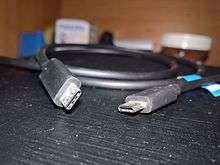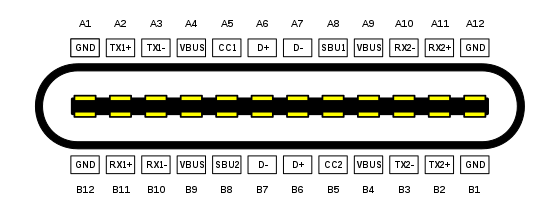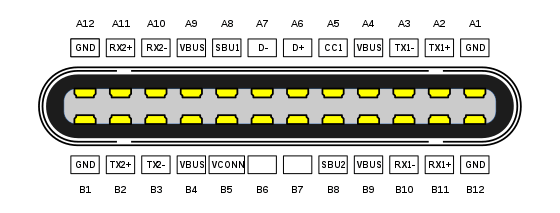USB Type-C


USB Type-C is a USB specification for a small 24-pin fully reversible-plug connector for USB devices and USB cabling.[1]
The USB Type-C Specification 1.0 was published by the USB Implementers Forum (USB-IF) and was finalized in August 2014.[2] It was developed at roughly the same time as the USB 3.1 specification.
If a product implements USB Type-C, it does not necessarily support USB 3.1 or USB Power Delivery. [3]
Details
The USB Type-C connectors connect to both hosts and devices, replacing various Type-B and Type-A connectors and cables with a standard meant to be future-proof.[4][5] The 24-pin double-sided connector is slightly larger than the micro-B connector, with a USB Type-C port measuring 8.4 millimetres (0.33 in) by 2.6 millimetres (0.10 in). The connector provides four power/ground pairs, two differential pairs for non-SuperSpeed data (though only one pair is populated in a USB Type-C cable), four pairs for high-speed data bus, two "sideband use" pins, and two configuration pins for cable orientation detection, dedicated biphase mark code (BMC) configuration data channel, and VCONN +5 V power for active cables.[6][7][8] Connecting an older device to a host with a USB Type-C receptacle requires a cable or adapter with a Type-A or Type-B plug or receptacle on one end and a USB Type-C plug on the other end. Legacy adapters with a USB Type-C receptacle are "not defined or allowed" by the specification, due to their being able to create "many invalid and potentially unsafe" cable combinations.[9]
USB 3.1 Type-C to Type-C cables are considered full-featured USB Type-C cables and must be active, electronically marked cables that contain a chip with an ID function based on the configuration channel and vendor-defined messages (VDMs) from the USB Power Delivery 2.0 specification. USB Type-C devices may optionally support bus power currents of 1.5 A and 3.0 A (at 5 V) in addition to baseline bus power provision; power sources can either advertise increased USB current through the configuration channel, or they can support the full power delivery specification using both BMC-coded configuration line and legacy BFSK-coded VBUS line. USB 2.0 Type-C to Type-C cables are only required to contain e-marker chips if the cable supports 5A instead of the default 3A, which requires USB Power Delivery support.
Devices may be hosts or peripherals. Some, such as mobile phones, can take either role depending on what kind is detected on the other end. These types of ports are called Dual-Role-Data (DRD). When two such devices are connected, the roles are randomly assigned but a swap can be commanded from either end. Furthermore, dual-role devices that support USB Power Delivery may independently and dynamically swap data and power roles using the Data Role Swap or Power Role Swap processes. This allows for charge-through hub or docking station applications where the Type-C device acts as a USB data host while acting as a power consumer rather than a source.
Alternate Mode

An Alternate Mode dedicates some of the physical wires in the USB Type-C cable for direct device-to-host transmission of alternate data protocols. The four high-speed lanes, two sideband pins, and (for dock, detachable device and permanent cable applications only) two non-SuperSpeed data pins and one configuration pin can be used for alternate mode transmission. The modes are configured using VDMs through the configuration channel.
DisplayPort, HDMI and MHL Alt Modes has passive USB Type-C cables which allow direct pass-though of the native video stream. These cables contain respective valid DP, HDMI or MHL connector on the other end of the cable.[10][11][12] DisplayPort, HDMI and MHL Alt Modes also has active USB Type-C adapter cables which coverts the native video stream to other video interface standards (e.g. DP, HDMI, MHL, VGA or DVI). Thunderbolt (20Gbps) Alt Mode use ordinary passive USB 3.1 Type-C cables, while Thunderbolt3 (40Gbps), similar to high-power USB Power Delivery, requires specially tested cables that are electronically marked for high-speed.
| Name | Logo | Date | Supporting |
|---|---|---|---|
| DisplayPort Alternate Mode | |
published in September 2014 | DisplayPort 1.3.[13] |
| MHL Alternate Mode | |
announced in November 2014 [14] | MHL 1.0, 2.0, 3.0 and superMHL.[7][15][16] |
| Thunderbolt Alternate Mode | |
announced in June 2015 [17] | Thunderbolt 3 and DisplayPort 1.2.[17][18][19][20] |
| HDMI Alternate Mode | |
announced in September 2016 [21] | HDMI 1.4b.[11][22][23][24] |
Other serial protocols like PCI Express and Base-T Ethernet[25] are possible.
A Type-C device is not required to support any Alternate Mode. The USB Implementers Forum is working with its Alternate Mode partners to make sure that ports are properly labelled with respective logos.[26]
Connector pinouts and cable wiring
Connector pinouts
| Pin | Name | Description | Pin | Name | Description | ||
|---|---|---|---|---|---|---|---|
| A1 | GND | Ground return | B12 | GND | Ground return | ||
| A2 | SSTXp1 | SuperSpeed differential pair #1, TX, positive | B11 | SSRXp1 | SuperSpeed differential pair #2, RX, positive | ||
| A3 | SSTXn1 | SuperSpeed differential pair #1, TX, negative | B10 | SSRXn1 | SuperSpeed differential pair #2, RX, negative | ||
| A4 | VBUS | Bus power | B9 | VBUS | Bus power | ||
| A5 | CC1 | Configuration channel | B8 | SBU2 | Sideband use (SBU) | ||
| A6 | Dp1 | Non-SuperSpeed differential pair, position 1, positive | B7 | Dn2 | Non-SuperSpeed differential pair, position 2, negative[lower-alpha 1] | ||
| A7 | Dn1 | Non-SuperSpeed differential pair, position 1, negative | B6 | Dp2 | Non-SuperSpeed differential pair, position 2, positive[lower-alpha 1] | ||
| A8 | SBU1 | Sideband use (SBU) | B5 | CC2 | Configuration channel | ||
| A9 | VBUS | Bus power | B4 | VBUS | Bus power | ||
| A10 | SSRXn2 | SuperSpeed differential pair #4, RX, negative | B3 | SSTXn2 | SuperSpeed differential pair #3, TX, negative | ||
| A11 | SSRXp2 | SuperSpeed differential pair #4, RX, positive | B2 | SSTXp2 | SuperSpeed differential pair #3, TX, positive | ||
| A12 | GND | Ground return | B1 | GND | Ground return | ||


Cable wiring
The capabilities of USB Type-C cables depends on (1) USB modes supported, (2) Amount of power supported for charging and (3) Alternate modes supported by the cable. There are cables which support only USB 2.0 with up to 480 Mbps data rate. The cables which support USB 3.0/USB 3.1 Gen 1 can handle up to 5 Gbps data rate at full duplex and are marked as super-speed cable. The cables which support USB 3.1 Gen 2 handle up to 10 Gbps data rate at full duplex and are marked as super-speed+. The charging capacity of USB Type-C cables may go up to 5A (100W), but 3A (i.e. up to 60W) cables are commonly available. Support for alternate modes requires extra connections for optional pins as well - like additional super-speed lanes, and 'side-band use' pins. The support for alternate modes usually adds an extra bandwidth requirement to the cable - in addition to the bandwidth already needed for USB data transfer. There are USB-IF certification programs available for cables.
| Plug 1, USB Type-C | USB Type-C cable | Plug 2, USB Type-C | ||||||
|---|---|---|---|---|---|---|---|---|
| Pin | Name | Wire colour | No | Name | Description | 2.0[lower-alpha 1] | Pin | Name |
| Shell | Shield | Braid | Braid | Shield | Cable external braid | ✓ | Shell | Shield |
| A1, B12, B1, A12 |
GND | Tin-plated | 1 | GND_PWRrt1 | Ground for power return | ✓ | A1, B12, B1, A12 |
GND |
| 16 | GND_PWRrt2 | ✗ | ||||||
| A4, B9, B4, A9 |
VBUS | Red | 2 | PWR_VBUS1 | VBUS power | ✓ | A4, B9, B4, A9 |
VBUS |
| 17 | PWR_VBUS2 | ✗ | ||||||
| B5 | VCONN | Yellow |
18 | PWR_VCONN | VCONN power, for active cables[lower-alpha 2] | ✓ | B5 | VCONN |
| A5 | CC | Blue | 3 | CC | Configuration channel | ✓ | A5 | CC |
| A6 | Dp1 | White | 4 | UTP_Dp[lower-alpha 3] | Unshielded twisted pair, positive | ✓ | A6 | Dp1 |
| A7 | Dn1 | Green | 5 | UTP_Dn[lower-alpha 3] | Unshielded twisted pair, negative | ✓ | A7 | Dn1 |
| A8 | SBU1 | Red | 14 | SBU_A | Sideband use A | ✗ | B8 | SBU2 |
| B8 | SBU2 | Black | 15 | SBU_B | Sideband use B | ✗ | A8 | SBU1 |
| A2 | SSTXp1 | Yellow[lower-alpha 4] | 6 | SDPp1 | Shielded differential pair #1, positive | ✗ | B11 | SSRXp1 |
| A3 | SSTXn1 | Brown[lower-alpha 4] | 7 | SDPn1 | Shielded differential pair #1, negative | ✗ | B10 | SSRXn1 |
| B11 | SSRXp1 | Green[lower-alpha 4] | 8 | SDPp2 | Shielded differential pair #2, positive | ✗ | A2 | SSTXp1 |
| B10 | SSRXn1 | Orange[lower-alpha 4] | 9 | SDPn2 | Shielded differential pair #2, negative | ✗ | A3 | SSTXn1 |
| B2 | SSTXp2 | White[lower-alpha 4] | 10 | SDPp3 | Shielded differential pair #3, positive | ✗ | A11 | SSRXp2 |
| B3 | SSTXn2 | Black[lower-alpha 4] | 11 | SDPn3 | Shielded differential pair #3, negative | ✗ | A10 | SSRXn2 |
| A11 | SSRXp2 | Red[lower-alpha 4] | 12 | SDPp4 | Shielded differential pair #4, positive | ✗ | B2 | SSTXp2 |
| A10 | SSRXn2 | Blue[lower-alpha 4] | 13 | SDPn4 | Shielded differential pair #4, negative | ✗ | B3 | SSTXn2 |
| ||||||||
Software support
- Windows 10 and Windows 10 Mobile supports USB 3.1, USB Type-C, alternate modes, billboard, power delivery, audio accessory and USB Dual Role support.[27]
- Windows 8.1 added USB type-C and billboard support in an update.[28]
- OS X Yosemite supports USB 3.1, USB Type-C, alternate modes and power delivery.[29]
- Android Marshmallow works with USB 3.1 and USB Type-C.[30]
- Chrome OS supports USB 3.1 and USB Type-C starting with the Chromebook Pixel 2015 and supports alternate modes, power delivery, and USB Dual Role support.[31]
Hardware support
An increasing number of motherboards, notebooks, tablet computers, smartphones, hard disk drives, USB hubs and other devices released from 2014 onwards feature Type-C receptacles.
Some non-compliant cables with a Type-C connector on one end and a legacy Standard-A plug or Micro-B receptacle on the other end incorrectly terminate the Configuration Channel (CC) with a 10kΩ pullup to VBUS instead of the specification mandated[32] 56kΩ pullup, causing a device connected to the cable to incorrectly determine the amount of power it is permitted to draw from the cable. Cables with this issue may not work properly with certain products, including Apple and Google products, and may even damage power sources such as chargers, hubs, or PC USB ports.[33][34]
Relation to other specifications
USB-IF specifications
- USB Type-C Locking Connector Specification
- USB Audio Device Class 3.0 Specification / USB Audio over USB Type-C
- USB Type-C Cable and Connector Language Usage Guidelines
References
- ↑ Hruska, Joel (2015-03-13). "USB-C vs. USB 3.1: What's the difference?". ExtremeTech. Retrieved 2015-04-09.
- ↑ Howse, Brett (August 12, 2014). "USB Type-C Connector Specifications Finalized". Retrieved December 28, 2014.
- ↑ "USB Type-C Cable and Connector : Language Usage Guidelines from USB-IF" (PDF). Usb.org. Retrieved 2015-06-18.
- ↑ Ngo, Dong. "USB Type-C: One cable to connect them all". CNET. Retrieved 2015-06-18.
- ↑ "USB Type-C Connector Specifications Finalized". AnandTech.com. Retrieved 2015-06-18.
- ↑ "Technical Introduction of the New USB Type-C Connector". Intel.ActiveEvents.com. Retrieved 2015-06-18.
- 1 2 "MHL Alternate Mode reference design for superMHL over USB Type-C". AnandTech.com. 15 March 2016. Retrieved 2015-06-18.
- ↑ "Introduction to USB Type-C" (PDF). Microchip.com. Retrieved 2015-06-18.
- ↑ Universal Serial Bus Type-C Cable and Connector Specification Revision 1.1 (April 3, 2015), section 2.2, page 20
- ↑ "DisplayPort Alternate Mode on USB-C - Technical Overview" (PDF). usb.org. VESA. 20 October 2016.
- 1 2 "HDMI LLC - HDMI Over USB Type-C" (PDF). usb.org. HDMI LLC. 20 October 2016.
- ↑ "MHL Alt Mode: Optimizing Consumer Video Transmission" (PDF). usb.org. MHL, LLC. 18 November 2015.
- ↑ "VESA® Brings DisplayPort™ to New USB Type-C Connector". DisplayPort. 2014-09-22. Retrieved 2015-06-18.
- ↑ "MHL® – Expand Your World". MHLTech.org. Retrieved 2015-06-18.
- ↑ "MHL Releases Alternate Mode for New USB Type-C Connector". MHLTech.org. MHLTech.org. 17 Nov 2014. Retrieved 2015-06-18.
- ↑ "MHL Alternate Mode over USB Type-C to support superMHL". www.mhltech.org. www.mhltech.org. 6 Jan 2015. Retrieved 2016-11-15.
- 1 2 "Thunderbolt 3 – The USB-C That Does It All | Thunderbolt Technology Community". Thunderbolttechnology.net. Retrieved 2015-06-18.
- ↑ One port to rule them all: Thunderbolt 3 and USB Type-C join forces, retrieved 2015-06-02
- ↑ Thunderbolt 3 is twice as fast and uses reversible USB-C, retrieved 2015-06-02
- ↑ Thunderbolt 3 embraces USB Type-C connector, doubles bandwidth to 40Gbps, retrieved 2015-06-02
- ↑ "HDMI Press Release: HDMI Releases Alternate Mode for USB Type-C™ Connector". hdmi.org.
- ↑ "HDMI Alt Mode for USB Type-C Announced". anandtech.com.
- ↑ "A new standard will allow your USB-C devices to connect to HDMI". neowin.net.
- ↑ "HDMI Alt Mode for USB Type-C™ Connector". hdmi.org.
- ↑ "[802.3_DIALOG] USB-C Ethernet Alternate Mode". ieee. 2015-03-26.
- ↑ Cunningham, Andrew (2015-01-09). "USB 3.1 and Type-C: The only stuff at CES that everyone is going to use | Ars Technica UK". ArsTechnica.co.uk. Retrieved 2015-06-18.
- ↑ Microsoft. "Windows support for USB Type-C connectors". Microsoft MSDN. Retrieved 2015-09-30.
- ↑ Microsoft. "Update for USB Type-C billboard support and Kingston thumb drive is enumerated incorrectly in Windows". Retrieved 2015-12-08.
- ↑ "Using the USB-C port and adapters on your MacBook (Retina, 12-inch, Early 2015) - Apple Support". Support.Apple.com. 2015-05-28. Retrieved 2015-06-18.
- ↑ "Android – Marshmallow". Retrieved 2015-10-12.
- ↑ "Charge your Chromebook Pixel (2015)". Retrieved 2015-10-31.
- ↑ Universal Serial Bus Type-C Cable and Connector Specification Revision 1.1 (April 3, 2015), page 60, table 3-13, note 1
- ↑ Kif Leswing (5 November 2015). "Google Engineer Reviews Defective USB Cables on Amazon - Fortune". Fortune.
- ↑ "In response to the Type-C cable discussions".
External links
- The Universal Serial Bus Type-C Cable and Connector Specification is included in a set of USB documents which can be downloaded from USB.org.
-
 Media related to USB Type-C at Wikimedia Commons
Media related to USB Type-C at Wikimedia Commons